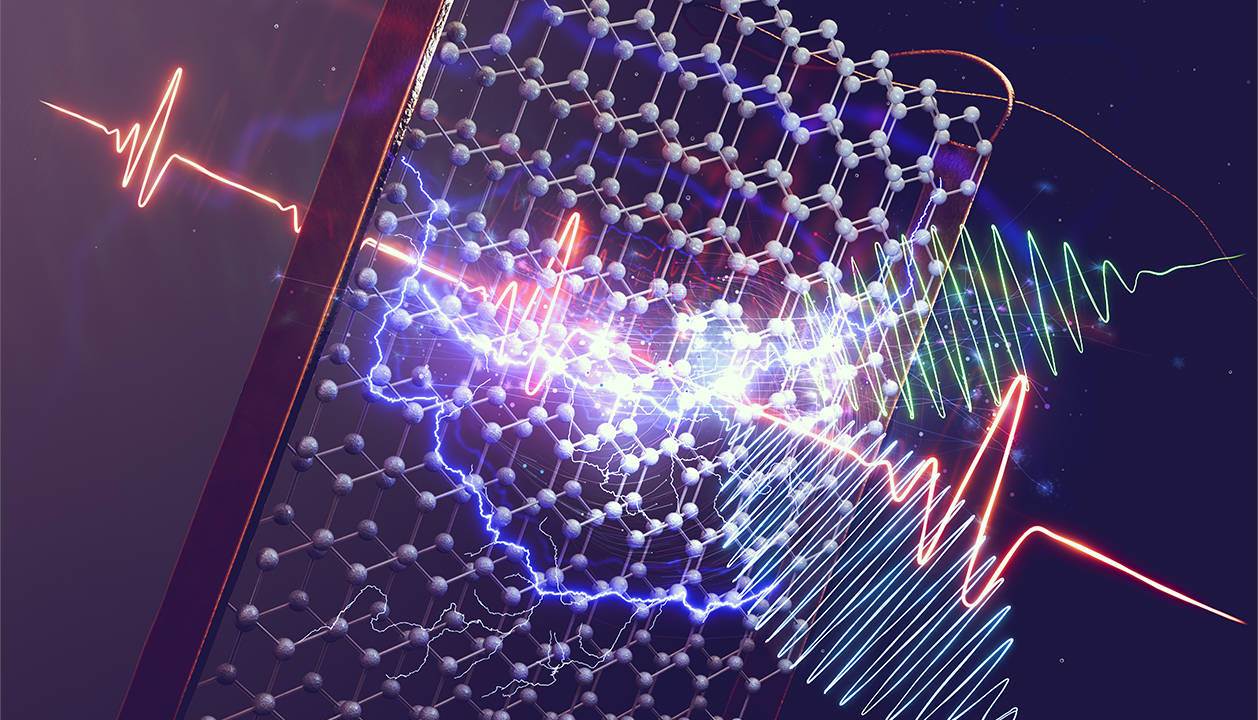Research
The Ménard’s lab focuses on the development of terahertz (THz) photonics techniques to investigate dynamical condensed matter systems.
The far-infrared region of the electromagnetic spectrum of light corresponding to optical wavelengths between 10 µm and 1000 µm, and known as the terahertz (THz) band, is one of the richest areas of research and development. Located between the near-infrared (NIR) and microwave regions, THz radiation covers an ideal photon-energy window to access many elementary excitations in materials such as phonons, plasmons, excitons, and molecular vibrations. THz unique properties can also be used to achieve high-speed wireless communication or image objects embedded in plastics, ceramics textiles, and many other materials considered as opaque. However, the generation, control, and detection of THz radiation remain technically challenging to this day. There is therefore a dire need for innovation in this field to improve state-of-the-art technologies and demonstrate new applications.
Our work can be decomposed into 4 axes of research:
THz slow-motion camera: single-pulse THz spectroscopy of real-time phenomena with µs resolution

We designed a system able to rapidly acquire successive THz waveforms to perform real-time monitoring of fast and non-reproducible phenomena [1,2]. In this configuration, each THz waveform is encoded on a chirped supercontinuum resembling a stretched rainbow (see picture). The detection is then ultimately determined by the repetition rate of the laser generating both the THz pulse and the supercontinuum. Although this rate can be well into the MHz range, in practice the technique is limited by the response time of the optical sensors and read-out time of components. Here we overcome this obstacle by using dispersive Fourier transform spectroscopy of the NIR pulse inside a km-long fiber. We achieve time-resolved THz spectroscopy with a table-top setup at record rates of 1 MHz. This innovative work lays the foundation towards resolving fast irreversible physical and chemical processes with time resolution approaching 1 µs.
[1] N. Couture et al. Single-pulse terahertz spectroscopy monitoring sub-millisecond time dynamics at a rate of 50 kHz. Nature Communications 14, 2595 (2023) [Link], [arXiv]
[2] N. Couture et al. Performance analysis of table-top single-pulse terahertz detection up to 1.1 MHz. Phys. Rev. Applied 21, 054020 (2024) [Link], [arXiv]
THz quantum photonics: single-THz-photon detection

We explore new techniques to detect THz radiation with unprecedented high sensitivity and fast response time [3]. We recently demonstrated a configuration combining a near-infrared single-photon counter with an electro-optic sampling configuration, whcih is a nonlinear optical process typically used to resolve a THz waveform. This detection technique allows us to transfer all information carried by a THz wave to near-infrared photons, which can be easily detected by a Si-based detector. The use of a single-photon counter allows us to push the detection limit to the single photon level. We believe this technology will contribute to address future needs in wireless communication systems to enable short-range data-hungry applications, like virtual reality or ultra-fast wireless data exchange between devices. Considering that the ultimate sensitivity of our configuration can approach the single-THz-photon resolution, new quantum THz experiments might soon be within reach.
[3] D. J. Jubgang Fandio et al. Zeptojoule detection of terahertz pulses by parametric frequency upconversion. Optics Letter 49, 1556 (2024) [Link], [ArXiv]
Quantum molecular materials via light-matter hybridization

During the last 30 years, physicists have used a range of advanced experimental techniques to explore the regime of strong light-matter coupling in many different physical systems. Recently, this quantum regime was achieved using the vibrational resonances of molecules coupled to the photonic mode of a cavity. These new hybrid states, half light, half molecules, have unique properties with an untapped potential of application in chemistry, biology and medicine. However, there are still many experimental challenges to overcome before the fascinating properties of these quantum electrodynamical systems can be turned into real-life applications. We demonstrated, both experimentally and numerically, crucial technical advances in cavity architecture to achieve the strong light-matter regime in a context relevant to chemical and biological applications. For the first time, several schemes of electromagnetic field confinement are explored and directly compared to facilitate the collective strong coupling of a localized photonic mode to a molecular vibration of glucose in the THz region. Using metasurfaces to effectively trap light inside molecular ensembles, we continue to explore this fascinating regime of strong light matter coupling with molecular compounds relevant to chemistry and health.
[4] A. Jaber et al. Hybrid THz architectures for molecular polaritonics. Nature Communications 15, 4427 (2024) [Link], [arXiv]
Nonlinear phenomena at low energies driven by high-field THz

Finally, we are also interested in developing new experimental geometries to achieve and explore the regime of high-field THz [5]. Recently we demonstrated a unique high-field THz source with a spectral peak centered at 2.6 THz. The setup relies on optical rectification of intense near-infrared pulses inside a GaP nonlinear crystal to generate THz peak fields up to 300 kV/cm. Our technique takes advantage of a phase grating directly etched at the surface of GaP, which enables a tilted-pulse-front configuration that optimizes phase-matching conditions. This high-field THz source will be used to drive coherent phenomena and explore nonlinear effects in the region between 2 and 4 THz. In parallel, we have explored the regime of extreme nonlinearities in 2D materials by monitoring the generation of THz high harmonics [6]. We demonstrated a device architecture combining a multilayered graphene design, electrical gating, and a metasurface substrate that can enhance harmonic generation efficiency by more than two orders of magnitude.
[5] W. Cui et al. High-field THz source centered at 2.6 THz. Opt. Express 31, 32468 (2023) [Link], [arXiv]
[6] A. Maleki et al. Strategies to enhance THz harmonic generation combining multilayered, gated, and metamaterial-based architectures. [arXiv]